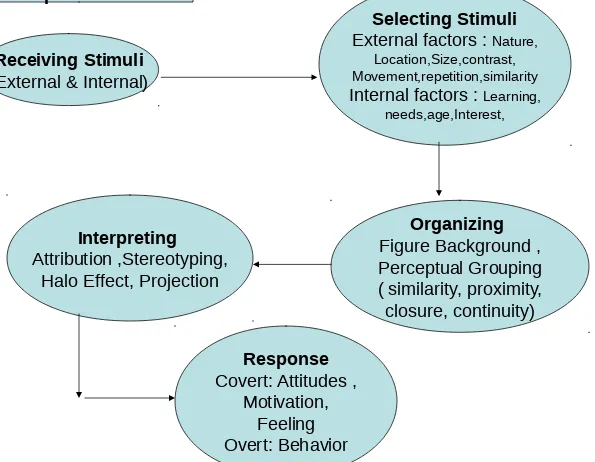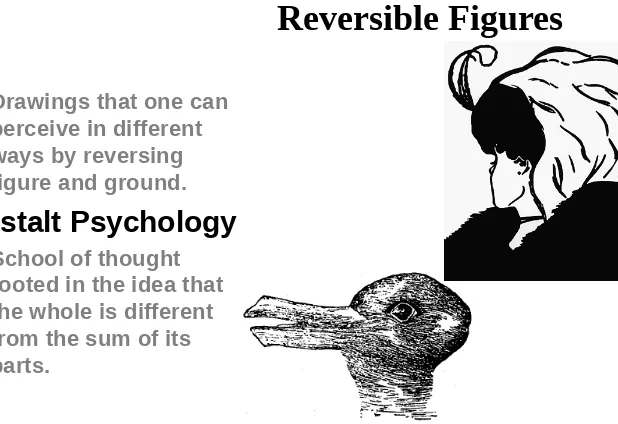Pengindera
an,Persepsi
,
1.
Syar
at
peng
indra
an ?
KEK
UAT
AN
OBJ
EK
ADA
NYA
PER
HAT
IAN
MAN
USIA
KES
EHA
TAN
Sudu
t pan
dang
dala
m
peng
indra
an ?
•
Pen
gatu
ran
men
urut
sud
ut p
anda
ng
ruan
g.
•
Pen
gatu
ran
men
urut
sud
ut p
anda
ng
wak
tu.
•
Pen
gatu
ran
men
urut
sud
ut p
anda
ng
Ges
talt.
•
Pen
gatu
ran
men
urut
sud
ut p
anda
PERSEPSI
Kemampuan otak dalam menerjemahkan
stimulus
disebut dengan
PERSEPSI
.
Persepsi merupakan proses untuk
•
Receiving Stimuli
(External & Internal)
Selecting Stimuli
External factors : Nature, Location,Size,contrast, Movement,repetition,similarity Internal factors : Learning,
needs,age,Interest,
[image:7.720.71.666.34.496.2]Organizing
Figure Background , Perceptual Grouping ( similarity, proximity, closure, continuity)
Response
Persepsi
Persepsi terhadap bentuk
Persepsi terhadap kedalaman
Persepsi terhadap konstansi
Pengaruh Perbedaan sudut pandang dalam
Pengindraan dan Persepsi dalam
Pembelajaran
Persepsi manusia baik berupa persepsi positif
maupun negatif akan mempengaruhi tindakan yang
tampak . Tindakan positif biasanya akan muncul
apabila kita mempersepsi seseorang secara positif
dan sebaliknya.
Sebagai contoh ketika kita mempersepsi siswa A
adalah siswa yang pandai maka kita akan
Peneli
tian ko
menta
r orang
tua te
rhadap
perilak
u anak
, Pene
muan
Jack C
anfield
(dalam
DePor
ter, 199
0)
Setiap
hari a
nak m
endap
atkan
:
460 ko
menta
r nega
tif
75 kom
entar p
ositif
S
ubjek
Pengamatan Persepsi Prasangka
• Dari su
dut pand
ang man
a kita m
engama
ti
perilaku
akan m
empeng
aruhi pe
rsepsi
yang ter
bentuk
• Persep
si manu
sia baik
+ maupu
n – akan
mempen
garuhi ti
ndakan
yang tam
pak
PENGERTIAN MEMORI, TERCAKUP DALAM TIGA
TAHAPAN/PROSES YAITU :
IN
STORAGE
MEMORI JANGKA PENDEK
• Disebut juga
immediate memory
dan
short term memory
.
• Informasi dalam memori ini bertahan hanya beberapa
detik.
• Contoh menghafalkan nomor telepon atau nomor plat
motor, setelah kita berhasil menghafalkan nomor
tersebut dan menggunakannya maka informasi tersebut
cenderung dilupakan atau hilang
• Kapasitas memori jangka pendek berkisar antara 2-7
digit
• Informasi yang ada pada memori ini sangat berarti atau
cenderung diulang maka kemungkinan besar informasi
tersebut bisa masuk memori kerja maupun memori
MEMORI KERJA
•
Memori kerja atau working memory dapat menyimpan
informasi dari
beberapa menit hingga beberapa jam
dan memberi waktu yang cukup untuk secara sadar
memproses, melakukan refleksi, dan melaksanakan
suatu kegiatan berfikir (Gunawan, A. W, 2003).
•
Informasi yang masuk dalam memori kerja juga
memungkinkan masuk ke memori jangka panjang jika
informasi tersebut bermakna dan sering diulang.
MEMORI JANGKA PANJANG
• Memori jangka panjang atau long term memory
merupakan kemampuan untuk menyimpan
informasi cenderung menetap/permanent.
Bebera
pa fakto
r yang
berpen
garuhte
rhadap
penyim
panan i
nforma
si jangk
a panja
ng
adalah
:
1. Inform
asi yang
berhubu
ngan de
ngan
keselam
atan hid
up
2. Inform
asi yan
g berh
ubungan
denga
n
memban
gkitkan
emosi
3. Inform
asi yang
masuk a
kal dan
FAKTO
R-FAK
TOR Y
ANG
MEMP
ENGA
RUHI L
UPA
• Decay
teori,
lupa ter
jadi kare
na wakt
u,
lama tid
ak dimu
nculkan
• Interfe
rensi te
ori,
informa
si yang
disimpa
n
saling b
ercamp
ur/tump
ang tind
ih
• Motiva
ted forg
etting
, inform
asi yang
ada
diharap
kan unt
uk dilup
akan
• Sebab
fisik,
kecelak
aan, am
nesia, u
sia
• Sebab
psikis,
stress, d
epressi,
MENI
NGKA
TKAN
KAPA
SITAS
MEM
ORI
•
Meng
organ
isasi
kan d
alam
kelo
mpok
terten
tu : m
eggo
longk
an tia
p 3 d
igit da
lam
meng
hapa
l nom
or hp
•
Meto
de m
nemo
nik
: meji
kuhib
iniu, m
au jad
i
koboi
haru
s bisa
naik
unta
•
Meto
de lo
ci
: men
gasos
iasika
n den
gan b
enda
yang
famili
ar
•
Mem
buat
pene
kana
n tert
entu
:
digar
is
bawa
hi,dib
aca k
eras,
samb
il dipr
Definisi
“ The study of perception is concerned with identifying the process through which we interpret and organize sensory information to
produce our conscious experience of objects and object relationship.”
“ Perception is the process of receiving information about and making sense of the world around us. It involves deciding which information to notice, how to categorize this information and how to interpret it within the framework of existing knowledge.
“ A process by which individuals organize and interpret their sensory impressions in order to give meaning to their environment.
•
Sensation
–
The processes by which our sense organs
receive information from the environment.
•
Transduction
–
The process by which physical energy is
converted into sensory neural impulses.
•
Perception
–
The processes by which people select,
organize, and interpret sensations.
The Perceptual Process
1.Sensation
– An individual’s ability to
detect stimuli in the
immediate environment.
2.Selection
– The process a person
uses to eliminate some
of the stimuli that have
been sensed and to
retain others for further
processing.
3.
Organization
–
The process of placing
selected perceptual
stimuli into a framework
for “storage.”
4.
Translation
–
The stage of the
perceptual process at
which stimuli are
•
Receiving Stimuli
(External & Internal)
Selecting Stimuli
External factors : Nature, Location,Size,contrast, Movement,repetition,similarity Internal factors : Learning,
needs,age,Interest,
[image:31.720.71.666.34.496.2]Organizing
Figure Background , Perceptual Grouping ( similarity, proximity, closure, continuity)
Response
Bottom-Up Processing
Prior Knowledge, Experience,
etc.
Prior Knowledge, Experience,
etc.
Stimuli Processing
Stimuli Processing
Perception
Perception
Stimuli Input
Top-Down Processing
Stimuli Processing
Stimuli Processing
Perception
Perception
Stimuli Input
Prior Knowledge,
Experience, etc.
Prior Knowledge,
Experience, etc.
Personality Temperament Culture Social Class ValuesBeliefs Prejudices Attitudes
Immediate Mental Set Presence of Authority Present Fatigue Energy Level Prior Stimuli Perceived Occupation Education
Needs, Moods
Mental Health Knowledge Vocabulary Specific Life
Experiences Long-term
Memory Schemas
Top-Down &
Bottom-Up Processing
Prior Knowledge, Experience,
etc.
Prior Knowledge, Experience,
etc.
Stimuli Processing
Stimuli Processing
Perception
Perception
Stimuli Input
Factors influencing perception
A number of factors operate to shape and sometimes
distort perception. These factors can reside in the
perceiver
, in the object or
target
being perceived or in
the context of the
situation
in which the perception is
•
Factors influencing Perception
Factors in the perceiver
• Attitudes • Motives • Interests • Experience • Expectations Perception
Factors in the Target
• Novelty • Motion • Sounds • Size • Background • Proximity • Similarity
Factors in the situation
• Time
Person Perception:
Making Judgments
Attribution Theory
When individuals observe behavior, they attempt to determine whether it is internally or externally caused.
observation Interpretation Attribution of cause
Consistency Consensus Distictinctiveness Individual behavior Internal External Internal External Internal External H L H L H L
Distictiveness
Does this person behave in
this manner in other situation
Yes High Consistency No Low Consistency No Low Consensus Yes High Consensus YES Low Distinctiveness NO High Distinctiveness Consensus
Do other person Behave in the Same manner?
Consistency
Does this person behave
in this same manner at other
times ?
Internal Attribution
Shortcuts in judging others
• Selective Perception :
People selectively interpret what they see on the basis of their
interests, background, experience and attitudes.
• Halo Effect :
Drawing a general impressions about an individual on the basis of a
• Contrast Effect :
Evaluation of a person’s characteristics that are effected by
comparisons with other people recently encountered who rank higher or
lower on the same characteristics.
• Projection :
Attributing one's own characteristics to other people.
• Stereotyping :
Judging someone on the basis of one’s perception of the group to which
Perceptual organization
• It is the process by which we group outside stimuli into recognizable and identifiable patterns and whole objects.
• Certain factors are considered to be important contributors on
assembling, organizing and categorizing information in the human brain. These are
- Figure ground
Figure-Ground Illustration
•Field-ground differentiation
– The tendency to distinguish
and focus on a stimulus that
is classified as figure as
PERCEPTUAL GROUPING
• Our tendency to group several individual stimuli into a
meaningful and recognizable pattern.
• It is very basic in nature and largely it seems to be
inborn.
• Some factors underlying grouping are
-continuity
Persepsi
Persepsi terhadap bentuk
Persepsi terhadap kedalaman
Persepsi terhadap konstansi
•
Perceptual Organization
•
Perceptual Constancies
•
Depth and Dimension
•
Perceptual Set
•
The World of Illusions
–
Drawings that one can
perceive in different
ways by reversing
figure and ground.
•
Gestalt Psychology
–
School of thought
rooted in the idea that
the whole is different
from the sum of its
parts.
Perceptual Organization
• Proximity
– Seeing 3 pair of lines in A
• Similarity
– Seeing columns of
orange and red dots in B
• Continuity
– Seeing lines that connect
1 to 2 and 3 to 4 in C
• Closure
– Seeing a horse in D
• Geons (geometric
icons) are simple 3D
component shapes.
• A limited number are
stored in memory.
• Geons are combined
to identify essential
contours of objects.
•
Size Constancy
–
The tendency to view an object as
constant in size despite changes in the
size of the retinal image.
•
Shape Constancy
–
The tendency to see an object as keeping
its form despite changes in orientation.
Perceptual Constancies
The Ames Room
• A specially-built room
that makes people seem
to change size as they
move around in it
• The room is not a
rectangle, as viewers
assume it is.
• A single peephole
• Even though these images cast shadows of
different shapes, they still are seen as
round.
Perceptual Constancies
•
Depth Perception
–
The use of visual cues to estimate depth and
distance.
•
Convergence
–
A binocular cue involving the turning inward of
the eyes as an object gets closer.
•
Binocular Disparity
–
A binocular cue whereby the closer an object is,
the more different the image is in each retina.
–
Distance cues that enable the perception of depth
with one eye.
• Relative Image Size • Texture Gradient • Linear Perspective • Interposition
• Atmospheric Perspective • Relative Elevation
• Familiarity
• Devised by Eleanor Gibson
and Richard Walk to test
depth perception in infants
and animals.
• Provides visual illusion of a
cliff.
• Caregiver stands across the
gap.
• Babies are not afraid until
about the age they can
crawl.
Depth and Dimension
• What is seen in the center figures depends on the
order in which one looks at the figures:
– If scanned from the left, a man’s face is seen.
– If scanned from the right, a woman’s figure is seen.
• The same physical
stimulus can be
interpreted differently
depending on
perceptual set, e.g.,
context effects.
• When is the middle
character the letter B
and when is it the
number 13?
Perceptual Set
–
Illusion in which
the perceived
length of a line
is altered by the
position of other
lines that
enclose it
The World of Illusions
–
Illusion in which the
perceived line length
is affected by linear
perspective cues.
• Side lines seem to
converge
• Top line seems farther
away
–
But the retinal images of
the red lines are equal.
The World of Illusions
© 2004 John Wiley & Sons, Inc.
Huffman: PSYCHOLOGY IN ACTION, 7E
Extrasensory Perception
• ESP refers to the ability to perceive
stimuli that are outside the 5 senses
– Telepathy:
the ability to read minds
– Clairvoyance:
the ability to perceive objects
or events
– Precognition:
the ability to predict the future


